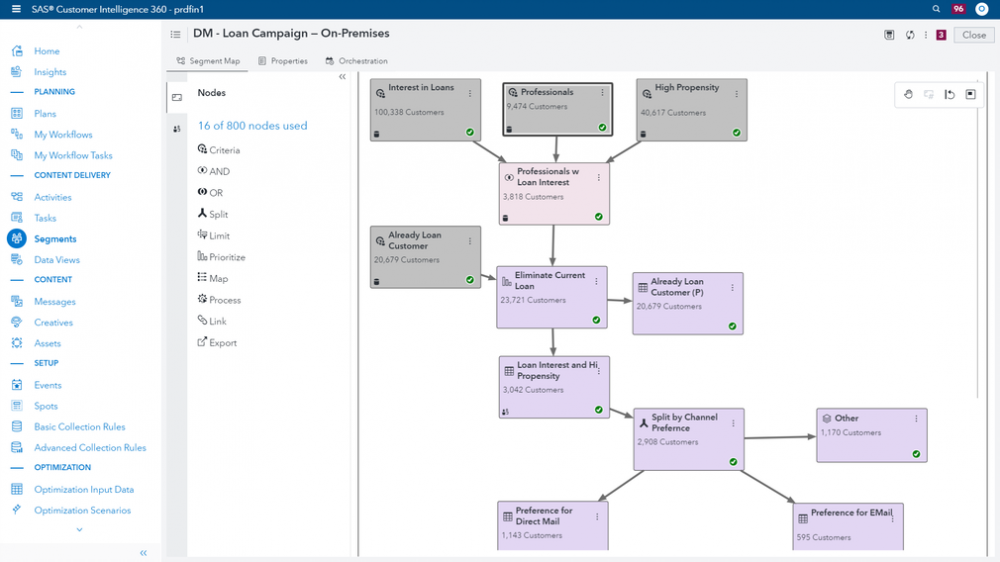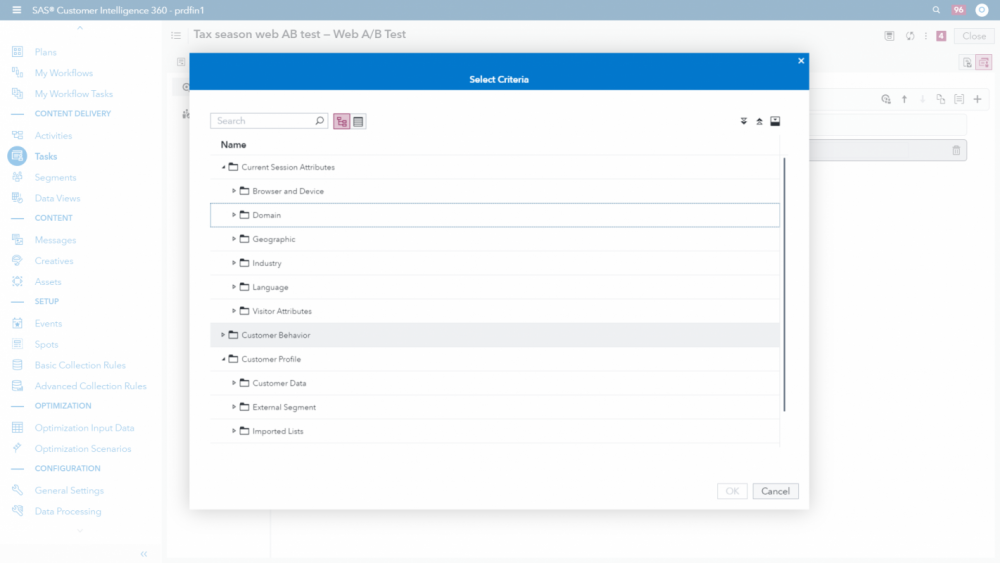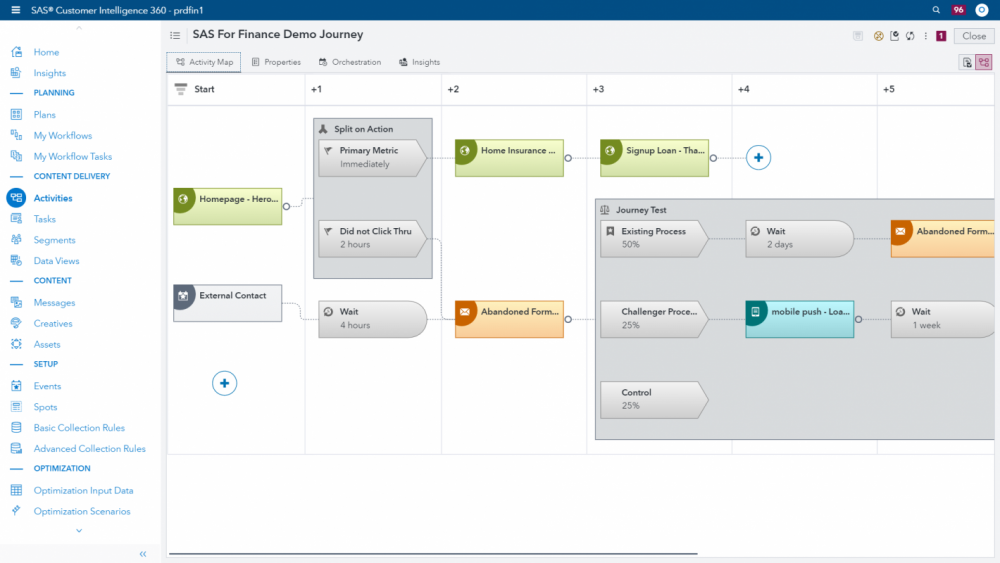
Of all the trends that we have seen in the marketing world over the last few years, very few have made as much of an impact as the Customer Data Platform (CDP). One of the main drivers of this is the rapid growth of digital channels and the need for marketing to have direct access to digital data combined with customer data to enable a personalized experience across channels.
However, most CDPs today focus purely on collecting data and not so much on the personalization that comes after that. And this still provides challenges for companies. SAS has built a solution from the ground up that combines CDP capabilities with omnichannel personalization in any channel. Organisations in every industry have moved quickly to adapt to these channels. They have created apps, mobile responsive websites and multichannel experiences so swiftly that in many cases, they have not paid enough attention to ensuring that the data coming out of these channels is stored in a way that is accessible to and actionable by every team in the business.
Crucially, organizations need this data to not only be standardised but actionable. By that I mean you need to use this behavioural data as targeting criteria when you segment your user base. You also need to use it to personalize the experience and be available to your analytics systems so that you can start to predict customer behaviours, generate recommendations and improve your customer experience.
The SAS approach to CDP: SAS Customer Intelligence 360
SAS Customer Intelligence 360 brings organizations several important benefits:
• The standardization and centralization of all your customer data from every part of the business.
• The ability to integrate this into other systems (analytics, marketing and reporting, among others).
• The capability to use this data to improve the customer experience through inbound and outbound marketing by using it to better target and personalize your customer communications.
Getting this right enables organisations to deploy true personalization at scale. According to McKinsey, "Personalization at scale has the potential to create $1.7 trillion to $3 trillion in new value." This is borne out by our customers’ experience as well. For example, ICA Banken saw a 10x improvement in conversion rates from its personalized and tightly targeted campaigns using SAS Customer Intelligence 360.
Let's dig into how SAS Customer Intelligence 360 handles your CDP requirements and creates a single, future-proofed platform for your customer insight and engagement needs.
Standardization and centralization of customer data
First on the list of core CDP capabilities is that the system must be able to standardize and centralize customer data from all parts of the business. Most organisations already collect data from point-of-sale systems (POS), social channels, web, email channels, e-commerce and more. Each system will very likely have a different way of uniquely identifying customers, collect only certain pieces of information or format the data in a different way. With no standardization of the data, it's impossible to compare customer behaviours across different channels or different stages in the customer life cycle. Without centralizing it, teams within your organization will struggle to access the data they need to generate actionable insights from the data you are paying money to collect and then store.
Previous attempts to make sense of all of this data have centred on the holy grail of creating a Single Customer View (SCV). Yet the SCV falls down when you want to take the step toward capabilities 2 and 3 in this post. The SCV approach can often lead to vast data lakes that are disconnected from action-oriented systems. They may be good for historical reporting. But they are less useful for running predictive analytics or using their data in marketing and advertising systems.
To address this, the SAS CDP approach uses the data hub within SAS Customer Intelligence 360 and standardizes and centralizes customer data around unique and persistent identities for each customer. You can easily combine data collected by SAS Customer Intelligence 360 with data from your offline customer channels – whether that is a call centre, CRM, POS, DMPs (like AdForm) or any other data source. By using the API gateways, you can bring together customer-level data from any other system.

This a segment map.
Integrated data
The CDP benefits really come into their own when you're not just dumping vast rows of customer clickstream or metadata into the system. Instead, we always recommend that our customers focus on the three most actionable types of customer data:
• Demographic (name, address, age, etc.).
• Analytic (propensity to buy a certain product in a given category, likelihood to be interested in a given service, etc.).
• Behavioural (when did they last visit the website, what rating they just gave the product they bought, what pages in the app they've seen in the last 30 days, etc.).
Typically, most organisations hold this information in entirely separate systems that don't talk to each other and manage them across several different teams. As a former digital marketer, I know the power of having access to these data points all in one system. They help me understand my audience's needs, segment them into different groups, treat them individually and even predict their behaviours. Having these three areas integrated into one system enables me to do smarter, more data-driven marketing. And it also saves the time and resource cost of individuals having to assemble all of this data each time they want to run a campaign.
The SAS Customer Intelligence 360 API gateway
The SAS Customer Intelligence 360 data platform API gateway can make this centralized and integrated data available to other systems. This means that merchandising teams can better forecast stock availability when they have a view of what times of day new customers are likely to be browsing the website. It means that development teams can build better apps, websites or even in-store experiences when they know how different segments of customers engage with what they're building. Integrated and accessible data is what has driven the rapid growth of tech newcomers like Netflix and Spotify, but even existing organisations can benefit from a strong CDP strategy.

Screenshot of an open tab that contains demographic, analytic and behavioural data all in one view, e.g., the pop-up window when selecting targeting criteria.
Improving CX with targeting and personalization
More organisations we work with are reorganising around customer-centric communications. And the Net Promoter Score (NPS) is becoming a key metric by which their success is being measured. As such, the final CDP feature that we're looking at today is the ability to use this information to improve your inbound and outbound customer messaging, thereby improving your CX.
Blanket email blasts sent to every single customer with no personalization do not make for happy customers. Therefore, using your CDP data to understand the right time to engage each individual customer is essential. A true CDP must have the ability to translate this information into action through execution. It must have the capability for your teams to build segments of customers, orchestrate multichannel journeys to them, and personalize every touch point based on the latest information about each customer. Whether customers call into your call centre or receive your latest outbound campaign, you can enhance their experience by making the most of the information you already hold on them.

A screenshot in this example of a multichannel journey (perhaps the outbound finance activity map).
SAS Customer Intelligence 360 helps your organisation do this with advanced multichannel marketing hub capabilities. These allow you to set triggers for inbound journeys and plan out complex multichannel outbound journeys. Recently, SAS was named a Leader in The Forrester Wave™: Cross-Channel Campaign Management (EMSS Modules), Q3 2019, showcasing this final – and arguably most – important component of a CDP solution.
Bring it all together for real success
By putting SAS Customer Intelligence 360 at the heart of its operations and using our CDP for execution and orchestration, Italian gift card company Epipoli saw rapid improvements in several key metrics:
• Reduced cost of customer acquisition by 34%.
• Optimized marketing spending 26%.
• Increased its customer base by 11%.
• Boosted the average value of transactions by 29%.
• Raised conversion rates by 23%.
SAS is uniquely placed to help your organization with your CDP use cases due to our market-leading omnichannel capabilities. We can help you take your existing data and make it work harder to benefit you and your customers. We can also help you learn more about your customer behaviours and how to optimize them.
Learn more about how SAS can help you with your CDP use cases here: SAS Customer Intelligence 360.
Oliver Sheerin is Customer Intelligence Solutions Advisor at SAS.


27 t/m 29 oktober 2025Praktische driedaagse workshop met internationaal gerenommeerde trainer Lawrence Corr over het modelleren Datawarehouse / BI systemen op basis van dimensioneel modelleren. De workshop wordt ondersteund met vele oefeningen en pra...
29 en 30 oktober 2025 Deze 2-daagse cursus is ontworpen om dataprofessionals te voorzien van de kennis en praktische vaardigheden die nodig zijn om Knowledge Graphs en Large Language Models (LLM's) te integreren in hun workflows voor datamodel...
3 t/m 5 november 2025Praktische workshop met internationaal gerenommeerde spreker Alec Sharp over het modelleren met Entity-Relationship vanuit business perspectief. De workshop wordt ondersteund met praktijkvoorbeelden en duidelijke, herbruikbare ri...
11 en 12 november 2025 Organisaties hebben behoefte aan data science, selfservice BI, embedded BI, edge analytics en klantgedreven BI. Vaak is het dan ook tijd voor een nieuwe, toekomstbestendige data-architectuur. Dit tweedaagse seminar geeft antwoo...
17 t/m 19 november 2025 De DAMA DMBoK2 beschrijft 11 disciplines van Data Management, waarbij Data Governance centraal staat. De Certified Data Management Professional (CDMP) certificatie biedt een traject voor het inleidende niveau (Associate) tot...
25 en 26 november 2025 Worstelt u met de implementatie van data governance of de afstemming tussen teams? Deze baanbrekende workshop introduceert de Data Governance Sprint - een efficiënte, gestructureerde aanpak om uw initiatieven op het...
26 november 2025 Workshop met BPM-specialist Christian Gijsels over AI-Gedreven Business Analyse met ChatGPT. Kunstmatige Intelligentie, ongetwijfeld een van de meest baanbrekende technologieën tot nu toe, opent nieuwe deuren voor analisten met ...
8 t/m 10 juni 2026Praktische driedaagse workshop met internationaal gerenommeerde spreker Alec Sharp over herkennen, beschrijven en ontwerpen van business processen. De workshop wordt ondersteund met praktijkvoorbeelden en duidelijke, herbruikbare ri...
Deel dit bericht